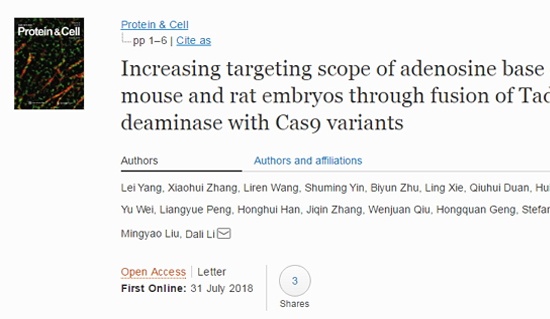Chinese team discovers new weapon for gene therapy: adenine base editing system
Recently, scientists from East China Normal University and Sun Yat-sen University have successfully cooperated to improve the ABE gene editing system. The related results were published in the journal Protein & Cell on July 31, 2018. The DNA base consists of adenine (A), thymine (T), cytosine (C) and guanine (G), which are arranged in a specific order to encode genetic information. The ABE system converts adenine (A) into guanine (G), so it can be a tool for scientists to change the genetic code. Since almost half of human genetic diseases are caused by C/G to T/A mutations, this mutation can be ideally corrected by the ABE system, so this is a promising therapeutic technique that can be used not only for making Specific animal disease models can also be used directly for gene therapy. Mice and rats are the two most important model organisms in biological and medical research because they are easy to raise and multiply and are physiologically similar to humans. Using transgenic rodent models, scientists have made significant advances in understanding human biology, disease pathology, and methods for treating a variety of diseases. However, even with targeted gene editing techniques like CRISPR/Cas9, it is not easy to generate a mouse (or rat) disease model containing a specific gene mutant. In this study, a team led by Dr. Li Dali of East China Normal University, using the improved ABE system, effectively produced three mouse strains to mimic the hereditary muscle degeneration disease known as Dunchenne Muscular Dystrophy (DMD). They also used a rat model to mimic type II hereditary glycogen storage disease, GSD or Pompe disease. These models are important resources for testing innovative therapies, especially gene therapy. Dr. Li Dali said: "It is important to expand the target range of the ABE system and test its efficiency and editing window in cells and animals." His research team at East China Normal University used chemically modified "guiding RNA" (gRNA). To improve overall editing efficiency, and to achieve targeted editing of genomic loci not covered by the original ABE system. “The results of the study are full of hope.†Dr. Li Dali said, “We are working hard to apply this powerful tool to preclinical treatment research to develop new gene therapy strategies for different human genetic diseases. Despite the overall efficiency of ABE. And the improvement of the delivery system is still a challenge, but I believe that clinical applications will be realized in the near future." Source: Bio-Exploration Shaanxi Changsheng Industrial Co., Ltd. , https://www.cncsbio.com
